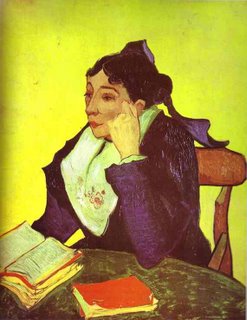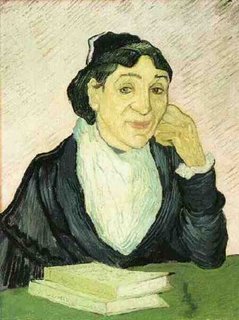Van Gogh Portrait, For Sale At Christie's, Reflects Tragic Link
 Bloomberg
BloombergApril 24 (Bloomberg) -- On May 2 at Christie's International in New York, a major Van Gogh comes under the hammer. The picture about to be sold, ``L'Arlesienne, Madame Ginoux'' is estimated to fetch $40 million though the final price may be much more.
For many years Van Gogh's ``Portrait of Dr. Gachet'' held the record for a painting at auction -- $86.5 million paid in 1990 by the late Japanese businessman Ryoei Saito.
``L'Arlesienne, Madame Ginoux'' is a work deeply interwoven with the artist's life, the brief period during which he shared a house and studio with Paul Gauguin, and the tragedy of his mental illness. The picture that is to be auctioned was done from a drawing, and -- this is one of the fascinating features of it --a drawing not by Van Gogh but by Gauguin.
Its sitter is Marie Ginoux (1848-1911), the wife of Joseph- Michel Ginoux, proprietor of a seedy bar, the Cafe de la Gare on Place Lamartine in Arles. This place had opened in early 1888, shortly before Van Gogh arrived in Arles, and was an all-night establishment near the train station catering to, among others, street-walking prostitutes.
Seeking Ruin?
From May to mid-September 1888, Van Gogh lodged in this cafe, a few doors away from his studio in the Yellow House, 2 Place Lamartine. The Cafe de la Gare was the subject of his celebrated work ``The Night Cafe'' -- done in the second week of September -- of which he famously said that this was a place ``where one can ruin oneself, go mad or commit crimes.''
Van Gogh had rented the Yellow House in May but could not afford to furnish the bedrooms and sleep there until the early autumn. During this time, he saw Marie Ginoux on a daily basis. The Ginoux family numbered among his few friends in Arles where the artist was unpopular -- children threw cabbage stalks at him as he passed by. He later recalled Madame Ginoux saying to him, ``When you are friends, you are friends for a long time....''
It was not until after he had moved into the Yellow House, and Gauguin had arrived, that she actually sat for a portrait. At the beginning of November 1888, probably on Saturday Nov. 2 or Sunday Nov. 3, Marie Ginoux posed in the studio of the Yellow House. On that occasion, Van Gogh painted the masterpiece known as ``L'Arlesienne'' (Musee d'Orsay), straight off in an hour or, as he states in one letter, 45 minutes. This was an amazing feat, presumably aided by hours spent observing the model previously.
`L'Arlesienne'

In that same hour or so, Gauguin produced a drawing (Fine Arts Museums, San Francisco) intended as a preparatory study for his own picture of the Ginoux's bar, ``The Night Cafe.'' Van Gogh later did a second version of his ``L'Arlesienne,'' probably as a gift to the sitter, then left the subject for over a year.
In early 1890, he quickly produced five new paintings of Madame Ginoux, based on Gauguin's drawing, which the latter had left in the Yellow House when he departed abruptly at Christmas 1888. Van Gogh used the other painter's work as a basis for several reasons.
He was averse to painting without a model, and his own pictures of Madame Ginoux were no longer in his possession. Also, using Gauguin's drawing made these new pictures a kind of collaboration, a memory of their fraught yet productive time together. As he put it in a letter to Gauguin, to whom he gave one version, it was a picture ``belonging to you and me as a summary of our months of work together.''
There was another reason. Marie Ginoux had fallen ill with an unspecified disease at the very time of Van Gogh's own mental crisis and ear-mutilation at Christmas 1888. She had remained bed- ridden intermittently afterward. In his mind, which was inclined to wild connections, she became a surrogate for himself. Vincent wrote to the Ginoux couple in December 1889 from the asylum in St. Remy, where he was then living, emphasizing this kinship in affliction.
Uncle Tom, Tiny Tim
In 1890, when he painted her portrait once more from Gauguin's drawing he placed on the table beside her two books, Charles Dickens's ``Christmas Carol'' and Harriet Beecher Stowe's ``Uncle Tom's Cabin.'' These were novels he read and reread while in the hospital at Arles, apparently because they told of suffering patiently bourne by Tom, Bob Cratchit and Tiny Tim.
Vincent, pathetically, informed Marie Ginoux that good would come of their misfortunes. The title he gave Dickens's fable in French -- ``Contes de Noel'' or Christmas Tales -- was a reminder that both he and she fell ill at Christmas time (in his case, Dec. 23, 1888).
Of the surviving canvases of Madame Ginoux from 1890, the one coming up for sale is the most optimistic. The others -- in museums in Rome, Sao Paulo and Otterlo, the Netherlands -- show her dressed in black. Only in this picture, which has been in the collection of the Bakwin family of New York since 1929, is she clad in white with wallpaper behind her decorated with spring flowers. This was the picture Van Gogh gave to Gauguin as a token of friendship.
Asylum Petition
Vincent continued to write warmly to his other ``absent friends'' in Arles, the Ginoux, until shortly before he committed suicide in July 1890. He never found out that -- as I discovered while researching my book, ``The Yellow House'' (Fig Tree, 18.99 pounds) -- Joseph-Michel Ginoux was one of the signatories to a petition to the mayor of Arles in February 1889, requesting that the artist be locked up in an asylum as a danger to the public.
Nor did he know that Ginoux was one of five witnesses who gave additional evidence against him to the police. This episode caused Van Gogh anguish and fury and was a factor in his decision to take refuge in the asylum at St. Remy.
On Feb. 22, 1890, the painter traveled from St. Remy to Arles with one of his five new paintings of Madame Ginoux to present to the sitter as a sign of fellowship in adversity. But before he got to the Cafe de la Gare, he suffered an attack of his mental illness and the painting disappeared. If you ever see a picture answering to its description in a Provencal junk shop, snap it up.

0 Comments:
Post a Comment
<< Home